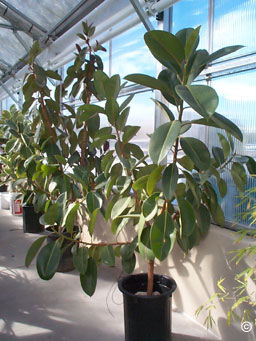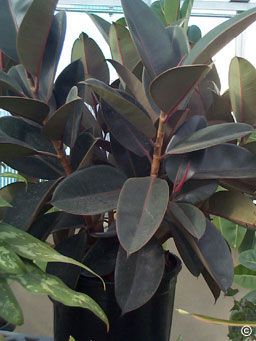
Rubber plants (Ficus elastica) hail from Southeast Asia and in their native habitat can grow to be 50 foot high trees. As a house plant their height is considerably less and will fit into most any home or office environment.
This houseplant has broad, leathery leaves and a tree-like habit that provides a bold focal point. When a stem or leaf is broken it exudes a milky sap that some people find irritating to the skin.
In an office or home it prefers warm temperatures and high humidity. Day-time temperatures of 80 degrees Fahrenheit or more, and night-time temperatures above 65 
degrees are perfect. To increase humidity cluster houseplants together or set on a pebble-filled saucer with a bit of water in the bottom. As the water evaporates it will increase the humidity around the plant. Be sure the plant sits above the water level to avoid saturating the soil.
Proper light levels are important for the health of the rubber plant. They do best in medium to bright filtered light. Unfiltered, direct sunlight can damage leaves. Plants should also be kept away from drafts – furnace or air conditioner air flow and drafty doors, especially during winter.
Rubber plants require an evenly moist soil, but keeping the soil saturated will cause root problems. To avoid this problem, be sure to use a pot that has adequate drainage. If the container is set inside a decorative pot or on a saucer, be sure to discard the excess water after each watering so the plant is not sitting in water. In addition to rotting roots, too much (or too little) water can cause leaves to drop off the plant.
For more information, see the following Planttalk Colorado™ video(s).



